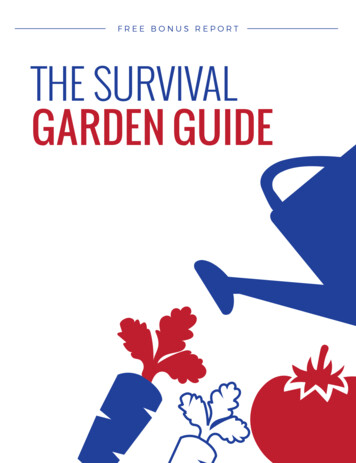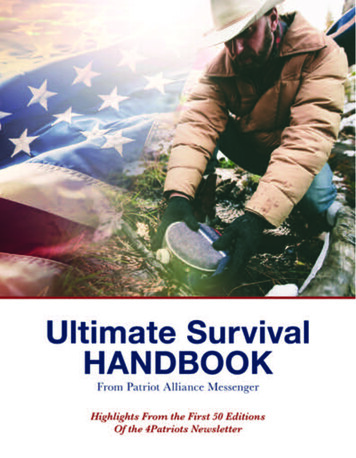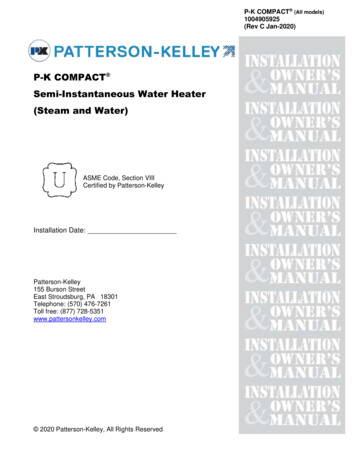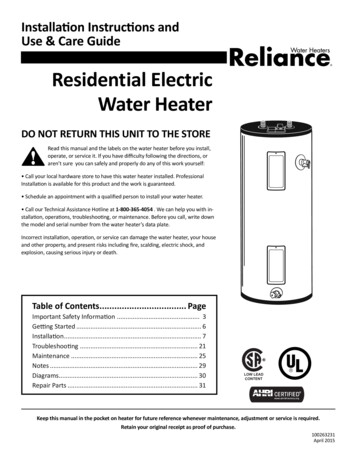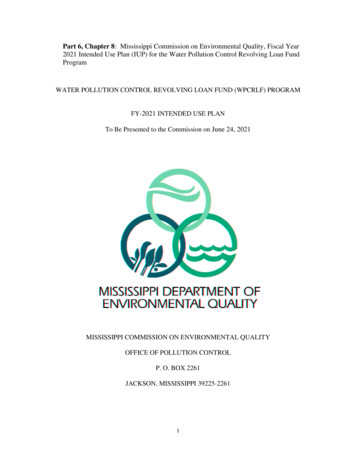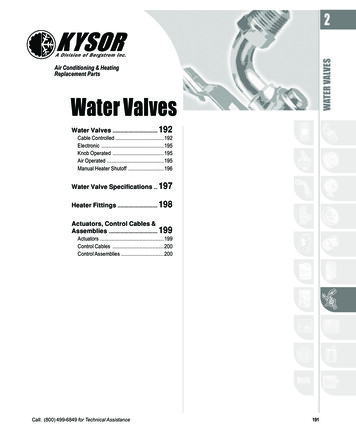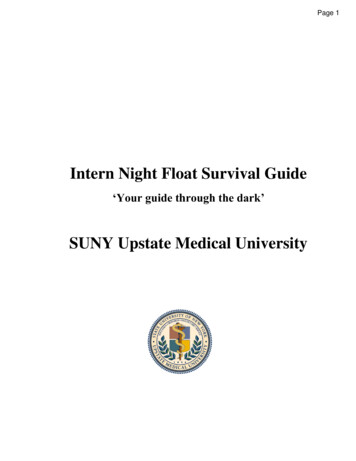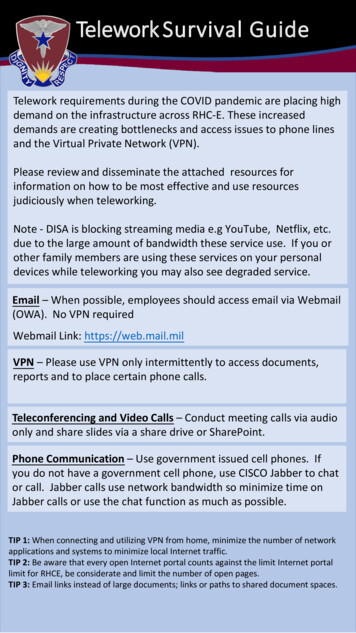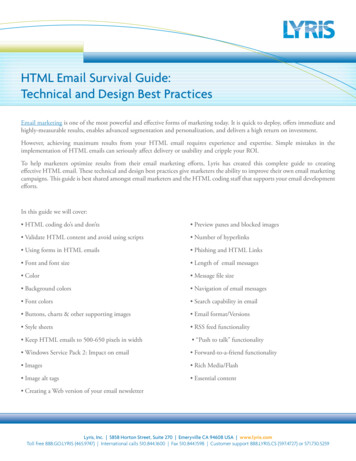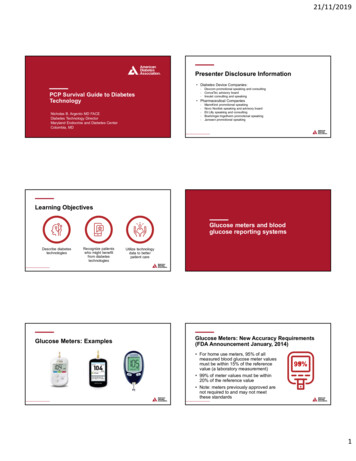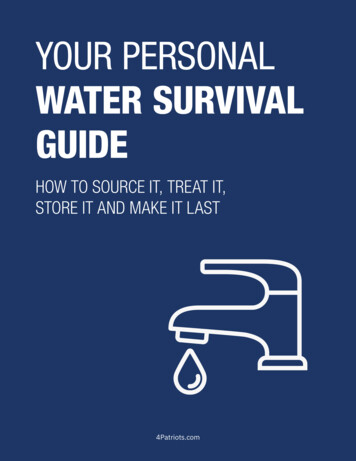
Transcription
YOUR PERSONALWATER SURVIVALGUIDEHOW TO SOURCE IT, TREAT IT,STORE IT AND MAKE IT LAST4Patriots.com
Copyright 2021 — 4Patriots.comFor educational use only — see Terms & Conditions and Disclaimersat 4Patriots.com
YOUR PERSONAL WATER SURVIVAL GUIDEYOUR PERSONALWATER SURVIVALGUIDEHOW TO SOURCE IT, TREAT IT,STORE IT AND MAKE IT LASTINTRODUCTIONWhen you are thirsty, need to do dishes ortake a shower, you simply walk to the sink orbathtub and turn the handle on the faucet.Most people in the United States have neverturned that handle and been met with a lack offlowing water. It is for that reason that manyfind it so easy to take water for granted.While the infrastructure in this country hasbeen traditionally strong, it has becomevulnerable in recent years. This has beenproven many times over when various naturalor manmade disasters left portions of thepopulation without clean water for a periodof time. Some of these contaminations havestarted at the source. More often water hasbecome contaminated en route to homes andbusinesses. Especially when it travels throughaging lead pipes.It is possible to live without food for quite afew days, but this is not the case with water.14 PAT R I OT S .CO MIf your access to water were to be cut off, youwould need to find a way to get clean drinkingwater in order to survive. And quickly.What if there were no running water due toan incident that interrupted the flow frommunicipal sources or from your well? Orwhat if you did have running water, but it wascontaminated by acts of terrorism, flooding orin other ways?Many people assume the Federal EmergencyManagement Agency (FEMA) or the RedCross will come to their aid in such situations.However, disasters stretch those organizationstoo thin, and the effects of these crises oftenmake it impossible to reach stranded people.We’ve seen this time after time over the pasttwo decades. The devastation of Hurricane2021 COPYRIGHT
H O W T O YSOOUURR CT OSRI TI VAANL DG MPEE RI TS, OTNRAELA TWIATT, ESRUER VU IADKEE I T L A S TKatrina, which slammed the Gulf Coast in2005, is one of the most well-known examplesof why being prepared is important. After thewinds subsided, many residents thought theyhad dodged a bullet. When the levees failed,however, many died while praying for rescuersto reach them.man walked for four hours until he reached aflooded grocery store. He was able to find acase of water, which he then dragged back tohis home. It took rescuers six days to reachhim and his wife. Had he not found that water,it is unlikely they would have survived.More recently, Hurricanes Harvey insoutheastern Texas, Sandy in the Northeast,and Irma, Matthew, Michael, Florence, Dorian,Laura and Sally in Florida and other statesdevastated the landscapes and took a numberof lives. In nearly every case we saw that it cantake days and weeks before power is restored,supply chains are reopened, and clean drinkingwater returns to homes and businesses.That is why you must have a plan that includeswater storage and how to source and collectwater in an emergency. There are any numberPSONAL WAT E RcouldS U R V resultI V A L GinUIaDEofE Rsituationsthatneed for youto be self-sufficient when it comes to water,food and other essentials.YOURFew will ever forget the images of men, womenand children huddled on rooftops and of deadbodies left on sidewalks. Not to mention thehorrific conditions in the Louisiana SuperdomeThis guide will teach you the basics of suchwhere many went to seek shelter. Some said itpreparation. Start making plans today. Youwas safer out in the storm than in that facility.never know when your preparation will meanthe difference between life and death.When Hurricane Ike bore down on the Gulfof Texas in 2008, some residents scrambledto evacuate. Flooding that took place muchearlier than anticipated thwarted evacuationplans for many, forcing them to ride out theGENERAL PREPARATIONstorm.WHEN A DISASTER IS IMMINENTOne of the hardest hit areas was Galveston.As previously mentioned, you should beginThree-quarters of the homes in Galvestonyour emergency planning today. Waiting for awere damaged or destroyed. Sadly, many whodisaster to be imminent could mean you dohad tried to follow the orders to evacuatenot have the time needed to properly prepare.were killed when the flooding forced them toObviously, some disasters will come withoutstay. Many who did survive were faced withwarning. Others might give you some time, butthe daunting task of getting through the firstyou may find it difficult to find the items youseveral days until rescuers could reach them.need.Because they had planned to leave, many didnot have any water or food to sustain them.The stories of survival are amazing. One older2021 COPYRIGHTThat being said, there are some steps you cantake when you know a disaster is coming.4 PAT R I OT S .CO M2
YOUR PERSONAL WATER SURVIVAL GUIDEFill Bathtub: Fill the bathtub, sinks and anyother containers you can get your hands onwith water. Some people keep five-galloncontainers on hand, but even if you do nothave such large containers, fill anything youcan with water. Keep in mind that water storedin containers that are not food grade shouldonly be used for sanitary purposes rather thanfor drinking. Still, you should collect as muchwater as possible in the hours leading up tothe disaster.disasters for which there will be no warningwhatsoever. They include: Acts of war Terrorism Tornadoes Flooding Earthquakes WildfiresWhen such disasters strike, you will eitherbe prepared or you will not. Take to heart thereality that good preparation can save your lifeand the lives of those you love.STORING WATERBuy Extra Cases of Water: This is a step thatreally illustrates the importance of preparingahead of time. If you wait until a disaster iscoming, you will probably have a hard timefinding cases of water. Thousands of peoplewill also be attempting to prepare at the lastminute and bottled water will be one of thefirst things to sell out.Still, if you do not have a good supply of wateron hand, you should try to find some even if itmeans driving to several stores to do so.YOU WON’T ALWAYS HAVE WARNINGRunning around to several stores looking forwater in the hours before a hurricane or otherdisaster is inconvenient, but at least you willhave a chance to prepare. This is not alwaysgoing to be the case. There are many types of34 PAT R I OT S .CO MHOW MUCH TO STOREHow much water you should store depends onmany factors such as the number of people inyour household, how much storage space youhave and how long you would like your supplyto last.Obviously, the more water you have, the moreprepared you will be. But the fact is, mostpeople simply do not have the space to storesufficient amounts of water for the long term.That is why your preparation should includeplans of where to source and how to collectwater, as well as how to purify it.The general rule of thumb is that you shouldhave one gallon of drinking water per dayper person. While this is more than isgenerally needed per day to survive, if you areparticularly active – for example, clearing2021 COPYRIGHT
HOW TO SOURCE IT, TREAT IT, STORE IT AND MAKE IT LASTdebris in the hot sun – then you will need todrink more.You should also have another one-half gallonor so per person for sanitary purposes and forhandling other tasks, such as rinsing dishes.If you assume 1½ gallons of water per personper day, you will be in good shape. You shouldaim for at least a three-day supply, but that isa bare minimum. How many days’ worth youdecide to store is up to you, but you should tryto store as much as possible.In all cases, you want to be sure to storewater away from light and heat. A cool, darkspace is best. You also want to be mindful ofthe potential for containers to leak. For thisreason, you should not store bottles where aleak could damage wood floors or cause othertypes of damage.For those with limited space, the types ofcontainers you choose is important. Thereare options that enable you to stack thecontainers, allowing for more storage in alimited space. If feasible, take advantageof space under beds or consider dedicatingpart of an extra closet to your storage. Somepeople raise their bed for the purpose ofadding extra storage space beneath.Storing water outside is not ideal. Asmentioned above, you want to avoid extremetemperatures and sunlight. If it is your onlyoption, aim for storage in a carport or othercovered area where you can at least avoiddirect sunlight.Even if you have access to water, such asa stream or nearby lake, you still need toconsider a water storage program. Many typesof disasters could cause the water sourceto become contaminated, forcing you to relyon your stored water for survival if you can’tpurify it.WHERE TO STORE WATERSome people are lucky enough to have abasement or large garage in which they candedicate space for their emergency water andfood storage. Others live in small apartmentsand simply do not have the extra space. Still,if you are creative, you should be able to findways to store enough water to last your familyfor weeks in an emergency.2021 COPYRIGHTTYPES OF STORAGE CONTAINERSThere are many types of storage containersappropriate for storing water. Below are someideas.Repurposed Containers: These include sodabottles, juice bottles and any other containersyou have used that can be filled with water.There are a couple of things to keep in mindwhen using repurposed containers for waterstorage: Durability – These bottles and containerswere not designed for long-term use. Forthat reason, they are more apt to developleaks than containers designed to be moredurable. Clear – Many of these containers areclear. This makes it more likely that algae4 PAT R I OT S .CO M4
YOUR PERSONAL WATER SURVIVAL GUIDEmay develop as none of the light is beingfiltered. That being said, these containersare better than nothing. If you do userepurposed containers for all or some ofyour water storage, it is important to rotatethe water and to keep the water out ofdirect sunlight.Bricks: Water “bricks” allow you to safelyand easily store, transport and access yourwater supply. Some come with a convenientinterlocking design for easy stacking in BPAfree containers.Make sure to get the kind that contains three tofour gallons of drinking water and includes aneasy-opening lid, built-in spigot and carryinghandle. Very portable, they take up very littlespace.Boxes: Boxed water storage kits are a greatchoice for a number of reasons. The boxes, each of which holds fivegallons, can be stacked, making this agood choice for those with limited space.You can easily stack 20 or more gallons inmost closets and still be able to use thecloset for other purposes. The boxed water storage kits keep out lightcompletely, making this a good option forlong-term storage. Should you have to bug out, boxed waterstorage kits are easy to take with you.Unlike large barrels that can be too heavyto move, each box only weighs about 40pounds.Each kit includes a Mylar pouch you fill withwater. The pouch is then placed inside the boxfor easy stacking.Barrels: For large quantities of water storage,barrels are a good choice. You want to be sure54 PAT R I OT S .CO Mto buy barrels designed for water storage.These barrels will be made of food gradeplastic and will be resistant to light and algae.Water storage barrels can be purchased in avariety of sizes, including those ranging fromfive to 55 gallons. You will also need a siphonand a spout, and many barrels come withthem. If yours does not, they can bepurchased separately.Pouches: Mylar pouches, similar to those usedwith the boxed storage kits, are a good choicefor water storage that doesn’t take up a lot ofroom. Mylar pouches are available in a varietyof sizes, so you can tuck them away in anyextra small spaces around your home. Theyare also lightweight and easy to move.While they are not too easy to puncture, you doneed to treat them with care to avoid leaking.Prepackaged Water: In addition to containersyou fill with water, prepackaged water isanother option for your water storage plans.The most common would be jugs and cases ofdrinking water. These are fine for short-termstorage and must be rotated regularly.For long-term storage, consider the following:Canned Drinking Water: Canned drinkingwater is sealed in a number 10 can, just likedehydrated foods intended for long-termstorage. The water has been treated in a waythat makes it suitable for storage for up to30 years. The cans are easy to move, can bestacked and there is little chance of leaking.The downside is that the canned water is pricywhen compared to other options.Prefilled Pouches: Pouches containingindividual servings of drinking water are a greataddition to emergency kits kept in a vehicle,go bags or school emergency kits. Each pouchcontains about four ounces of drinking water.2021 COPYRIGHT
HOW TO SOURCE IT, TREAT IT, STORE IT AND MAKE IT LASTBoxed Drinking Water: Prepackaged boxeddrinking water is sold in four- and eight-ounceoptions. They are another good choice foremergency kits, but take up more room thanthe pouches.SHORT-TERM STORAGE TIPS For short-term storage, rotation isimportant. Be sure to use and replace yourcases of water, as well as water stored inrepurposed containers. For very short-term use, such as when adisaster is imminent, use the tips aboveand fill your bathtub, sinks and any othercontainer you can find. The water in thetub should be used for sanitary purposesrather than for drinking. This is also truefor any water stored in containers that arenot food grade or that once held non-fooditems.LONG-TERM STORAGE TIPSfor several years. It is very difficult to storeenough water for that period of time, which iswhy learning how to source, collect and purifywater is so important.SOURCING AND COLLECTING WATERSourcing and collecting water can beimportant for both the short term and the longterm. Even if you have stored
YOUR PERSONAL WATER SURVIVAL GUIDE. 3 4ATRIOTS.COM 2021 OPYRIGHT Y A IV Fill Bathtub: Fill the bathtub, sinks and any other containers you can get your hands on with water. Some people keep five-gallon containers on hand, but even if you do not have such large containers, fill anything you can with water. Keep in mind that water stored in containers that are not food grade should only be used .
